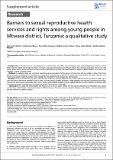| dc.contributor.author | Mbeba, Rita Moses | |
| dc.contributor.author | Mkuye, Martin Sem | |
| dc.contributor.author | Magembe, Grace Elias | |
| dc.contributor.author | Yotham, William Lubazi | |
| dc.contributor.author | Mellah, Alfred Obeidy | |
| dc.contributor.author | Mkuwa, Serafina Baptist | |
| dc.date.accessioned | 2021-08-17T12:11:34Z | |
| dc.date.available | 2021-08-17T12:11:34Z | |
| dc.date.issued | 12/26/2012 | |
| dc.identifier.citation | Rita Moses Mbeba, Martin Sem Mkuye, Grace Elias Magembe, William Lubazi Yotham, Alfred obeidy Mellah, Serafina Baptist Mkuwa. Barriers to sexual reproductive health services and rights among young people in Mtwara district, Tanzania: a qualitative study. Pan Afr Med J. 2012;13(Supp 1):13 | en_US |
| dc.identifier.issn | 1937-8688 | |
| dc.identifier.uri | http://dspace.amref.org/handle/123456789/68 | |
| dc.description | This article is published as part of the supplement “AMREF´s evidence in advancing the health of women and children”
Supplement sponsored by AMREF - African Medical and Research Foundation
© Rita Moses Mbeba et al. The Pan African Medical Journal - ISSN 1937-8688. This is an Open Access article distributed under the terms of the Creative Commons Attribution License (http://creativecommons.org/licenses/by/2.0), which permits unrestricted use, distribution, and reproduction in any medium, provided the original work
is properly cited. | en_US |
| dc.description.abstract | Background: In Tanzania over 1/3 of the population is under 24 years. Nationwide 23% of teenagers have started childbearing. However, Mtwara
Region has the highest percentage (25.5%) of teenagers who begin childbearing early. Mtwara District has a teenage pregnancy rate of 11% with
young people utilizing sexual reproductive health services (SRHS) less frequently than adults.This study aimed at gaining insights on barriers to the
utilization of SRHS in Mtwara district.
Methods: A qualitative study was carried out using focus group discussions, facility assessment interviews and case studies. A total of nine focus
group discussions (comprising 8 to10 persons per group) were conducted among girls (10-18 years), community leaders and adults. Data was transcribed using pattern matching methods then merged into relevant themes for analysis and interpretation.
Results: The study revealed that a good number of health facilities do not have skilled service providers (SPs) on sexual reproductive health rights.
Girls start sexual intercourse between 9 and12 years. Services sought included; education, family planning and voluntary counseling and testing.
However, the services were inaccessible due to lack of privacy, confidentiality, equipments and negative attitudes from SPs. Initiation ceremonies, early
marriages and gender disparities were mentioned as social-cultural barriers to SRH rights.
Conclusion: This study has demonstrated that factors such as lack of youth friendly services, gender disparity and unfavorable socio-cultural
practices may create barriers to accessing adolescent SRHS and rights. Therefore, there is a need to integrate youth friendly services in health facilities and advocate for behavior change. | en_US |
| dc.description.sponsorship | Department for International Development (DFID) | en_US |
| dc.language.iso | en | en_US |
| dc.publisher | Pan African Medical Journal | en_US |
| dc.subject | Youth friendly services | en_US |
| dc.subject | Reproductive health | en_US |
| dc.subject | Health services | en_US |
| dc.subject | Family planning | en_US |
| dc.subject | Counseling and testing | en_US |
| dc.title | Barriers to Sexual Reproductive Health Services and Rights Among Young People in Mtwara district, Tanzania: a Qualitative Study | en_US |
| dc.type | Article, Journal | en_US |

